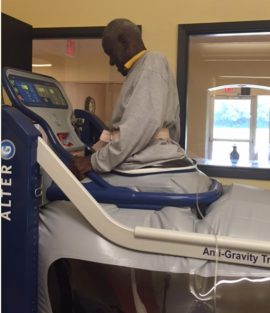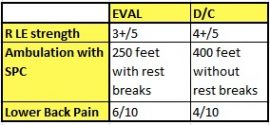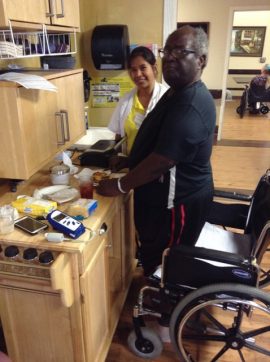Oftentimes, patients undergo various setbacks on the road to recovery. For instance, one of our patients, a 77-year-old woman with history of post-polio syndrome, had sustained a pathologic hip fracture related to osteoarthritis in January 2014. She underwent a L THA and was sent to a rehab center. A few days later, she developed a marked increase in pain and shortening of her leg. She had significant bruising on her entire leg and up into her back.
Our client was sent back to the hospital, where X-rays revealed the hip socket had dislodged into her pelvis. Over the next month, she changed surgeons and underwent additional surgeries to reconstruct her hip joint, including an impaction bone graft of her left acetabulum. She did not return to the previous rehab facility, but instead chose Sloan’s Lake Rehab.
Despite her history of polio as a child, our client had been fully independent and living alone in a duplex. She was able to walk without a device, drive and lead an active lifestyle as a senior in her community.
Intervention
When our client arrived at Sloan’s Lake, she was non-weight-bearing on her left lower extremity and totally dependent with all of her self-care tasks and mobility. She was limited by severe pain and weakness, and her family was extremely concerned about her care due to the complications she had sustained.
As the patient began her recovery, she slowly improved in all aspects of ADL tasks and mobility. Because she was not able to rely on her stronger left side, she began gaining strength in her weaker right side.
Our client was able to use adaptive equipment to dress, and she improved in her ability to transfer. After several weeks, her surgeon, Dr. Hugate, upgraded our client to 25 percent weight bearing, and she was able to take her first steps in the Alter G. Over time, our client gained confidence in addition to strength. The patient returned home at wheelchair level, and her son was able to take care of her until her next follow-up appointment.
When Dr. Hugate increased our client’s weight-bearing status to 50 percent, she again used the AlterG to walk and gain strength. One of her therapists accompanied her to the follow-up appointment, where she received full weight-bearing status. After tears of joy and hugs all around — six months after her original injury — our client returned to Sloan’s Lake to continue rehab. She was able to gradually work up to 100 percent weight bearing using the AlterG, and she began walking with a walker.
Results
Our client returned home for the last time — after a total of four inpatient admissions and two outpatient stints over the course of eight months — walking with a cane and able to complete all of her basic self-care tasks with modified independence. Her loss of independence was devastating to her, but she was somehow able to keep an amazingly positive attitude throughout her eight-month rehab process.
One of the revelations she had during rehabilitation was discovering that she had been compensating for her post-polio condition since childhood and had developed many strategies to offset her imbalances over several decades. Working with our client to achieve better balance, bilateral integration and strength and provide techniques for her to complete tasks without compensation allowed our client to return home stronger and more capable than she had been in years.
 At Richland Hills Rehabilitation & Healthcare, we have been pleased with the results of using the AlterG Anti-Gravity Treadmill. We had one client who presented with a history of COPD and HTN and was greatly limited by pain. As a former athlete, he was eager to participate in rehabilitation, but he struggled due to his comorbidities. The rehab team determined that he would be a great candidate for use of the AlterG.
At Richland Hills Rehabilitation & Healthcare, we have been pleased with the results of using the AlterG Anti-Gravity Treadmill. We had one client who presented with a history of COPD and HTN and was greatly limited by pain. As a former athlete, he was eager to participate in rehabilitation, but he struggled due to his comorbidities. The rehab team determined that he would be a great candidate for use of the AlterG.

